The Parrot Society UK
Veterinary Medicine and Parrot Conservation in Argentina
Dr. Antonio Sciabarrasi
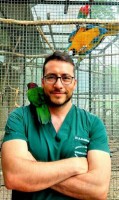
Antonio has been a veterinarian working with psittacine birds for more than 15 years, and he is head of the Fauna Hospital of La Esmeralda Rescue Center and of the Zoology and Ecology Chairs, both Institutions resident in Argentina. He is a writer for numerous scientific publications, a regular national and international speaker and author of the book Integral Management of Psittaciformes. He is an advisor to various parrot conservation programs in his country as well as in others in the Americas and Africa.
His work has covered more than 100 species of these birds, and the conservation programs include, in Argentina: Ara chloropterus, Primolius maracana, Primolius auricollis, Amazona vinacea, Amazona aestiva xanthopteryx and Forpus xanthoterygius among others. In Bolivia: Ara glaucogularis, Ara rubrogenys, Anodorhynchus hyacinthinus and Amazona tucumana. In Paraguay: Ara ararauna, and in Uruguay Amazona aestiva xanthopteryx. In Trinidad and Tobago Amazona amazonica tobagensis, and in Colombia Pionus chalcopterus, and Mexico Ara militaris and Amazona autumnalis. Finally, in South Africa: Poicephalus robustus and in Congo Psittacus erithacus.
He is a fervent supporter of captive breeding and the possession of those species that are legally permitted. However, the illegal trade in parrots is a scourge that negatively affects wild populations, as is the loss of habitat, among other threats.
To give an example of the type of work mentioned, this article will describe the methods used to reinforce a population of Amazona aestiva xanthopteryx in one of the two sites of its naturally active presence in the province of Santa Fe, Argentina. The following aspects were taken into account: the current status of the species; the presence of protected natural areas within the range of natural distribution of the species in the province; the function of the species in the ecosystem; as well as the existence of a captive population from confiscated birds, used as a potential reservoir to achieve the conservation of the genetic diversity of these parrots.
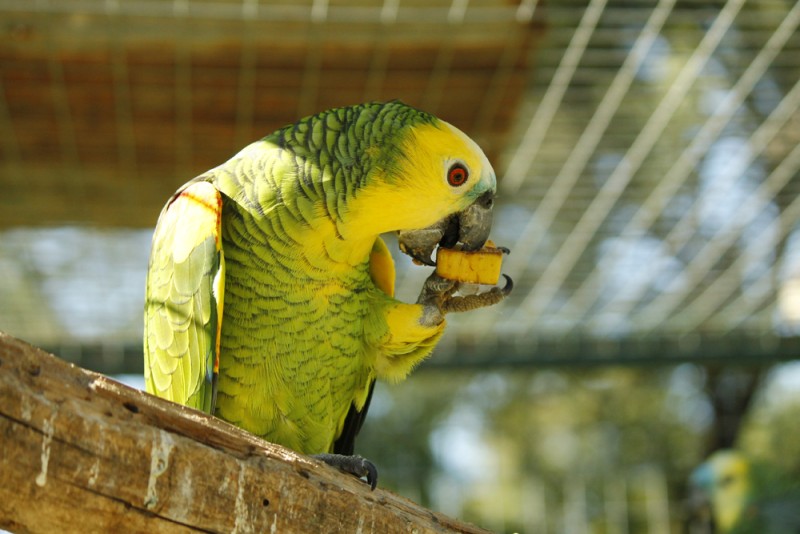
Parrots studied. 93 individuals of Amazona aestiva xanthopteryx were used. All the birds came from confiscations, were originally hatched in the wild and belonged to the subspecies that geographically occurs in Argentina. The handling of the specimens was based on age and they were divided into two flocks. Flock A consisted of 73 reproductive adult individuals (over 4 years old), and Flock B of 20 nestling and fledgling individuals (from 2 months to 3 years, pre-reproductive age).
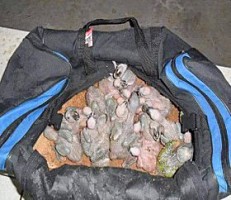
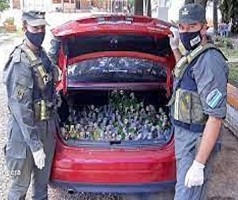
Confiscated chicks; a car boot full of confiscated parrots!
The entire process of reception, rehabilitation and release of individuals was carried out in accordance with the guidelines for the management of confiscated living organisms (IUCN, 2019) and the steps stipulated in the Management Plan of the Institution for Parrots called ¨Ñanddé Elé¨ (¨Our parrots¨) which includes work protocols. This process had the following steps: quarantine, clinical-physical-behavioural evaluation, evaluation of the release area and finally the release with monitoring, in compliance with the ad hoc form developed by this faunal institution.
The quarantine process was carried out at La Esmeralda facilities and was adjusted in each case to the guidelines of Resolution No. 731/11 of the National Service for Animal Health and Food Quality (SENASA, 2011). This period began with the traceability of each individual through ringing (Resolution 1/11 Ministry of Environment and Sustainable Development of the Nation) on the right leg in the case of being male, and on the left, in the case of being female. Sex was determined by DNA techniques to identify the sex chromosomes.
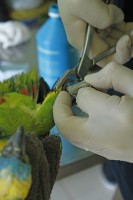
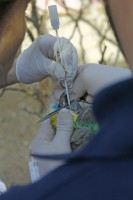
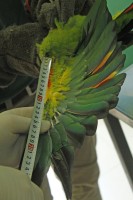
Affixing leg ring; throat swab for sample; measuring wing
For the physical-clinical evaluation, measurements were taken of head size, tibio-tarsal length, and body weight, direct examination and palpation were performed, plus other examinations involving radiology, ultrasound, etc. Blood samples were taken for further evaluation of the health status: complete blood biochemistry, and microscopic examination of blood smears; while droppings were examined for gastrointestinal parasites using flotation and sedimentation techniques. Gram staining for microscopic detection of bacteria and yeasts was done on samples of faecal matter, crop content, and conjunctival swabs; choanal swabs were tested for chlamydiosis by PCR tests. Blood was also tested for serological evaluation of the following diseases: avian influenza, chlamydiosis (OIE, 2006) herpesvirus, polyomavirus, paramyxovirus, adenovirus, flavivirus and circovirus; while ultrasound was used in the evaluation of fatty liver in adult parrots, and radiography to assess bone density.
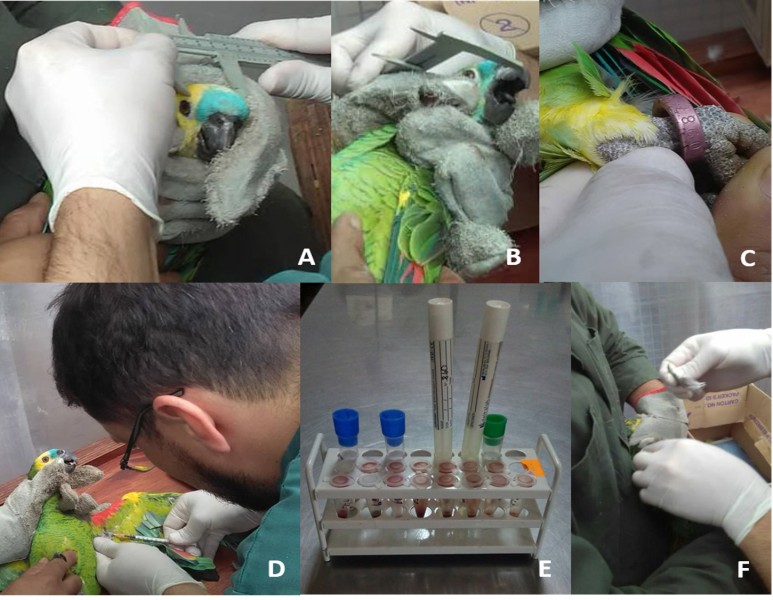
Various tests and measurements
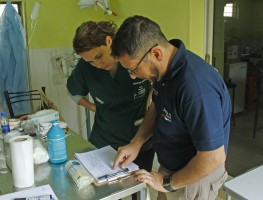
Checking results
The behavioural evaluation consisted of cataloguing individual behaviour patterns, characterising the spatial use and eating habits in enclosures. All these evaluations were carried out directly and non-invasively (e.g., using binoculars), and remotely with infrared video cameras. In the latter case, using the Instantaneous Scan method carried out manually by two independent observers who recorded the expressed behaviours in ad hoc spreadsheets in Excel. The behaviors in the ethogram were categorised according to the type of behaviour in: 1) stationary position; 2) locomotion; 3) maintenance; 4) feeding; 5) affiliation social interactions; 6) agonistic social interactions (divided into two subcategories, threat and submission); 7) non-agonistic social interactions; 8) reproduction and 9) other behaviours. This section evaluates: flight manoeuverability; perching on mobile and fixed surfaces, both vertical and horizontal; social interaction, gradual adaptation to natural diet, including the handling and recognition of wild foods and environmental enrichment. Some negative stimuli were used in order to provoke a flight response from humans. The environmental enrichment manoeuvres were carried out from 6 a.m. to 6 p.m.
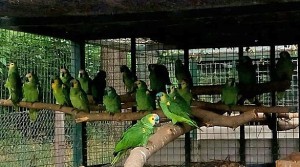
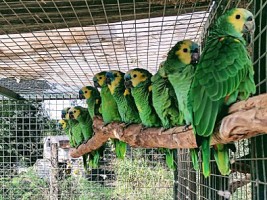
Birds in holding aviaries
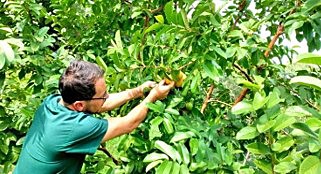
Collecting fresh fruit
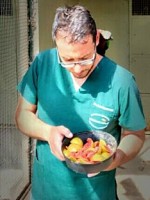
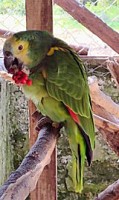
Feeding fresh fruit
For post release identification, on the pre-release days, the foreheads of the birds were coloured with natural black crayon for Flock A and red for Flock B. This colour lasts about 30 days on the bird under natural conditions - sufficient time to monitor the survival of the individual. The frontal colouring added to the traceable ringing and placement on the right leg in the case of males and left in the case of females, thus yielding more precise data on sightings.
Valuation of the potential release area. The analysis was carried out by technical personnel from the Provincial Directorate of Sustainable Management belonging to the Ministry of Environment and Climate Change of the Province of Santa Fe. A preliminary evaluation was carried out on the suitability of the habitat of the release area. Parameters measured included: structure of the vegetation and the degree of connection with levels of human influence, and the presence of important tree species for parrots, plus a detailed analysis of the satellite images of the area. Particular attention was paid to "high concentration" sites for psittacine species, such as the places where they spend the night (sleep, nest and eat). Potential "parrot concentration" sites make it easier to estimate their population size, observe their behaviour, and take clues to identify other important sites by observing daily and seasonal movements from these sites to others. Interviews with local residents gave added useful information.
Release and monitoring. This section was carried out using a schedule of sighting campaigns (On the 2nd and 15th days post-release) according to the methodology proposed by Durán (2000) and the guidelines proposed by Benítez (2000) for the release of parrots.
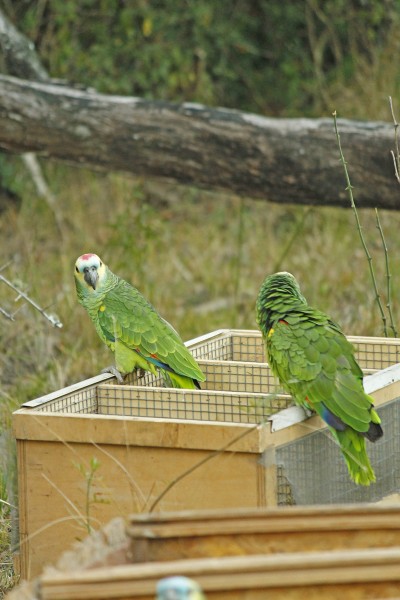
Birds ready for release - crayon mark on head clearly visible
Results. The rehabilitation and release processes were carried out using a flock format, based on the sociability of the species, where the relationship and bonding of individuals contributes to the social interactions necessary for the formation of pairs and hierarchies. Such behaviour promotes greater long-term survival, for example, by increasing the number of birds watching out for predators, a key component of reintroduction success.
The quarantine process was completed by all individuals as none showed any signs of infectious diseases. The physical-clinical-behavioral evaluation, begun at the end of the quarantine and developed throughout the rehabilitation process, yielded the following results:
⦁ Physical evaluation: 35 birds presented good all-round flight manoeuverability, with short and medium high flights predominating. Regarding the use of perches, in general a preference was found for horizontal hanging perches, followed by the feeding platform, the cage mesh, the trunks of large trees, and some vertical perches located inside the cage. Parrots were found to have good balance both on hanging perches and on vertical branches, so they should have no trouble adapting to a wild habitat. As time progressed, the parrots used the cage mesh less. During feeding, they were observed to use both their feet and their beaks to feed. Most of the individuals fed on the feeding platform, although there were some occasions when they took a little food, flew to a perch and consumed it there with the help of their feet to manipulate it.
⦁ Clinical evaluation: Identification of parasites from cloacal samples showed naturally reported species for A. aestiva xanthopteryx; in flock A: Capillaria sp., Trichostrongylus sp. and Strongyloides sp. and in B: Isospora sp. Specific treatment was given for these infections, but these reports did not limit their suitability for release.
⦁ Behavioural evaluation: most of the social interactions that were observed were positive, frequently seen in pairs (Flock A). These included: mutual grooming, requesting food and feeding from one member of the couple to the other, monitoring between members of the couple, vocalisations when being together and perching close together. Negative social interactions were very few (2%), and generally consisted of loud vocalisation and beak attack to drive an individual away from a particular site both on the perch and at feeding time on the platform. Negative external stimuli were also an important part of rehabilitation. The parrots (=35) reacted appropriately to the presence of the negative stimulus (e.g., abrupt movement of the containment mesh, screaming of humans when they appeared, vocalisations of birds of prey and their flights using falconry techniques). The stimulated birds flew in different directions and vocalised loudly.
⦁ Release and monitoring: The parrots were moved as a group, staying with the affiliations they had formed in the aviaries, transported in wooden boxes appropriate to the species, and accompanied by the necessary legal documentation. The release method was the so-called "Hard (or direct) Release" which does not include food supplementation or post-release health intervention. Flock A (adult birds), after 6 months of captive rehabilitation, was released in March 2019. Flock B (the juvenile birds), after 18 months of rehabilitation, was released in March 2020. On both occasions, this time of year coincided with the non-reproductive season and where the flocks are more variable in numbers of individuals and although the food supply begins to decline, the fruiting of many trees in that period coincides with the fruits used in the diet naturalisation stage carried out in captivity. At the time of release, in both groups, the individuals left immediately within one minute. All the individuals went directly to the trees near the release point. After approximately 15 minutes, they began the longest and highest flights. Such flights were accompanied by vocalisations from the entire group. This activity lasted approximately one hour. After the release, a legal document was drawn up, which consisted of the signatures of the locals and the rest of the people present, by way of certification and commitment.
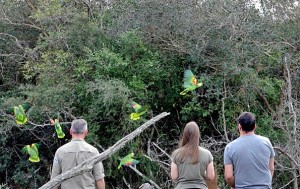
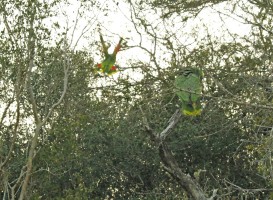
Flying free at last!
The follow-up was carried out through sightings where the coloured frontal spot was observed, as well as the presence of the leg ring. On the journey two days after the release (observations made by locals), several individuals were observed flying, vocalising and eating fruits in the nearby trees. One dead individual was found for each group, with the assumption that they had not adapted to the habitat, as they did not show signs of predation. On the 15th day of monitoring, the technical personnel observed only one individual from flock B sighting. Vocalisations were heard in the area, but no more released individuals were seen in the areas inspected.
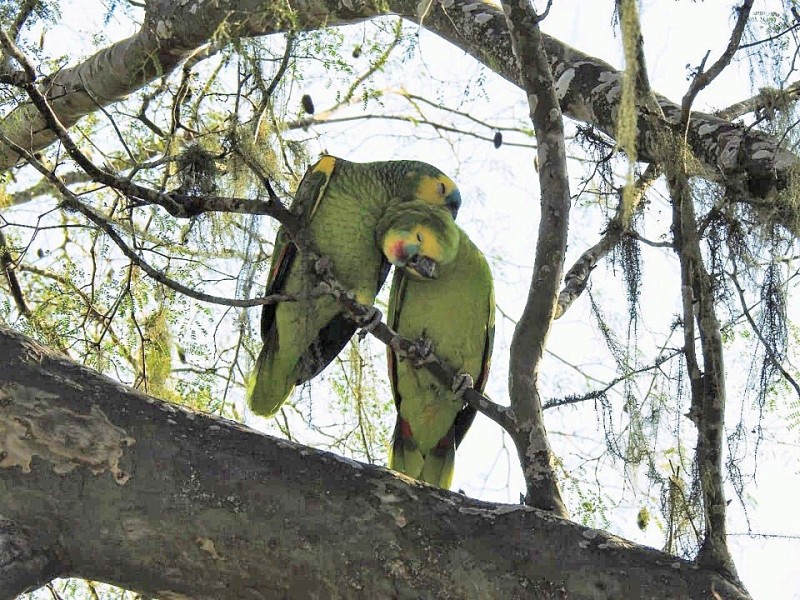
Free and mutual preening, with crayon mark still visible
Of the 93 birds, only 35 individuals were suitable, of which 20 belonged to group A and 15 to group B, the rest of the birds (n=58) were not included in the release due to either physical problems, disease or obesity, or had abnormal behaviors such as vocalisation of human language, walking on the ground, self-mutilation, voluntary approach to humans and displays of violent aggression against their peers. The unreleased animals returned to different categories of the program in order to try again and perhaps in the future they can return to nature or contribute to captive breeding and also be parrot ambassadors of their problems.
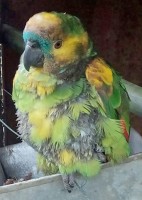
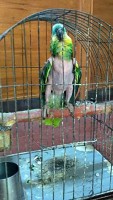
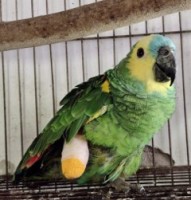
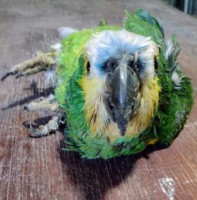
Various birds unsuitable for release: poor feather condition, lost limb, deformed limbs
Conclusions: The results of this project are still preliminary, so it is absolutely necessary to continue with the schedule of activities planned from the beginning of the project. One of the most important contributions of this project is the interdisciplinary development of management techniques (protocol) to be used in the restoration of wild populations, techniques that could be taken as methodologies to follow for the rehabilitation and release processes of parrots in Centers of Fauna in Argentina and other Neotropical countries.
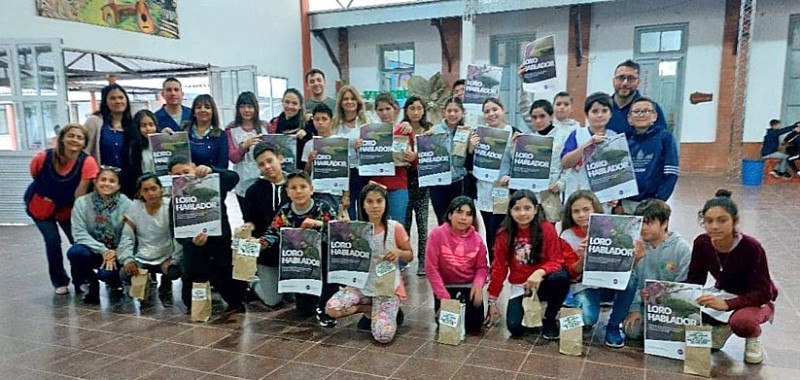
Passing on the conservation message by involving local school children
These preliminary results allow us to presume that the rehabilitation of parrots by the aforementioned methodologies will allow animals from confiscations for violations of wildlife laws to complete the rescue by being reintroduced into their natural environments.
